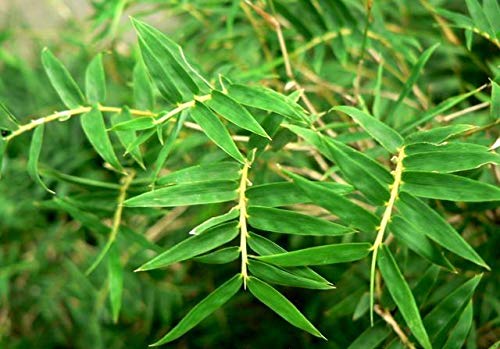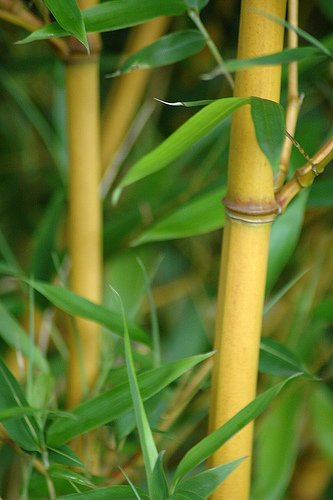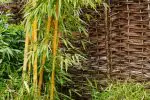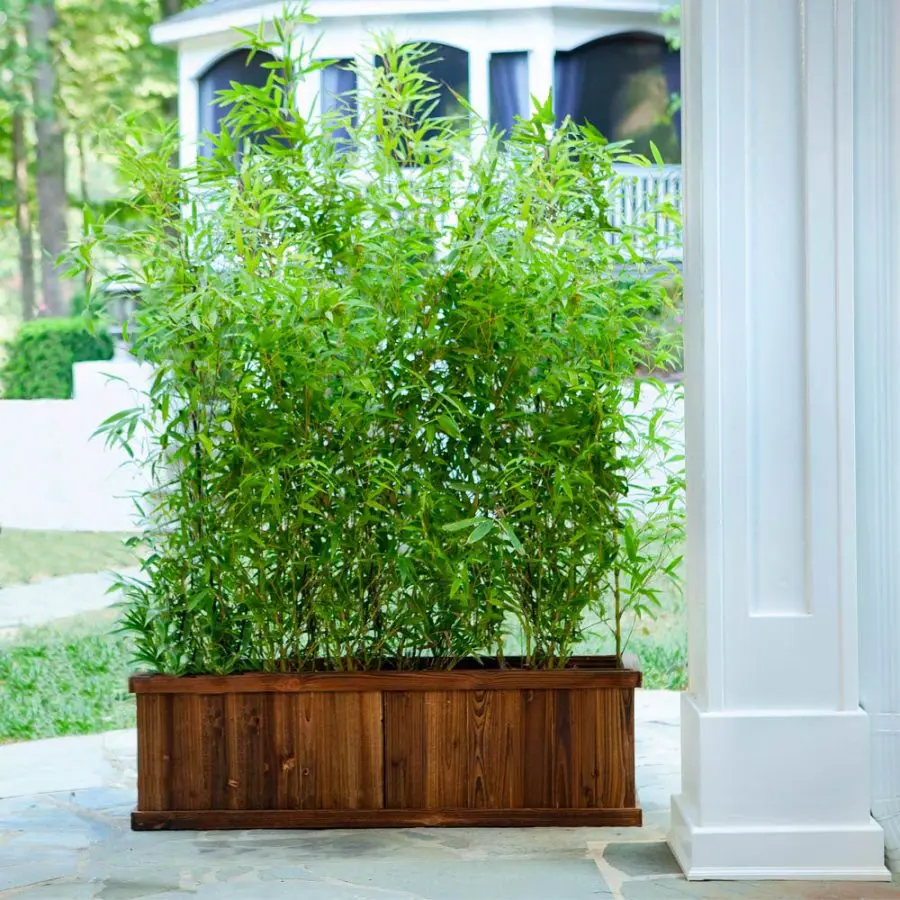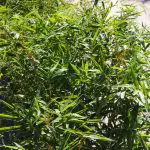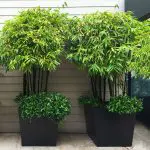This post contains affiliate links. If you buy something from one of our links we may earn a commission. Thanks
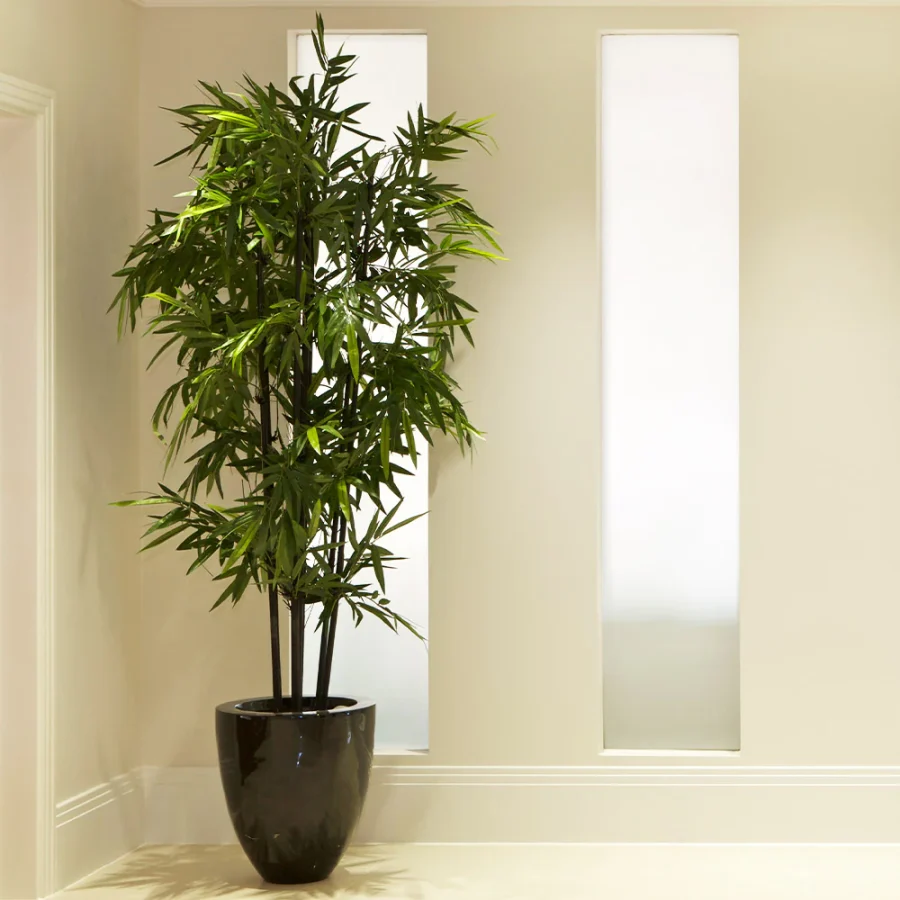
Discover the joys of bringing nature indoors by learning about growing bamboo in pots indoors!
To grow Bamboo in pots indoors, choose a well-draining pot and soil. Place the pot in an area with indirect sunlight and maintain a consistent watering schedule, allowing the soil to slightly dry between waterings. Fertilize lightly every 4-6 weeks for optimal growth. Indoor bamboo is generally low-maintenance and adapts well to indoor conditions.
With our easy guide, it’s never been simpler.
Are you looking for a way to bring a touch of natural beauty into your home? Look no further than growing bamboo in pots indoors!
And we’re not primarily talking about the lucky bamboo plant (dracaena sanderiana)although we do talk about it.
But this article is mostly about real bamboo that will add a unique and calming touch to your space.
With our guide, you’ll be on your way to growing your own indoor bamboo forest in no time.
Growing Bamboo In Pots Indoors Introduction
Hey there, plant lovers! If you’re anything like us, you’re always on the lookout for new ways to bring nature indoors.
That’s why we’re excited to share with you our guide on growing bamboo in pots indoors.
Not only is bamboo a stunning addition to any indoor space, but it’s also a relatively low-maintenance plant to care for.
And before you get excited about the prospect of growing lucky bamboo, it’s important to note that we’re talking about real bamboo – the kind that grows tall and strong in the wild.
So, let’s get started on your journey to growing your own indoor bamboo plants.
Benefits of Growing Bamboo in Pots Indoors
Bamboo is a fantastic plant to grow indoors for a number of reasons.
First and foremost, it’s a beautiful plant that can bring a unique and calming touch to any indoor space.
Additionally, bamboo is an incredibly versatile plant that can be grown in a variety of pot sizes and shapes, making it perfect for both small and large indoor spaces.
Growing bamboo in pots indoors also allows you to control the plant’s growth and size, making it easier to maintain than when planted in the ground.
It’s always the growing season indoors.
You can buy Multiplex Bambo On Amazon
Bamboo And Feng Shui
Bamboo has long been regarded as a symbol of good fortune and prosperity.
According to the principles of bamboo Feng Shui, placing this plant in the right location within your home can attract positive energy and bring good luck.
It is said that bamboo plants can even promote wealth, success, and prosperity.
Lastly, bamboo is known for its air-purifying properties, making it an excellent addition to any home or office.
Steps Involved in Growing Bamboo in Pots Indoors
The process of growing bamboo in pots indoors can be broken down into a few simple steps.
First, you’ll need to choose the right bamboo species for indoor growing, as some varieties are better suited for indoor cultivation than others.
Next, you’ll need to select the right type of pot and soil for your bamboo plant.
Once you have the right materials, you can plant your bamboo in the pot and begin caring for it.
Proper care involves regular watering, fertilization, and pruning to encourage healthy growth.
Lastly, you’ll need to troubleshoot any common problems that may arise, such as yellowing leaves or root rot, to ensure your bamboo plant stays healthy and strong.
Choosing the Right Bamboo
Now that you know about the benefits of growing bamboo in pots indoors, it’s time to choose the right bamboo species for your indoor oasis.
With so many varieties of bamboo to choose from, it can be overwhelming to know which one to select.
But don’t worry, we’ve got you covered! In this section, we’ll explain the different types of bamboo suitable for indoor growing and give you some tips on how to choose the right one for your space.
So, get ready to learn all about bamboo and find the perfect variety for your indoor garden!
Different Types of Bamboo Suitable for Indoor Growing
When it comes to indoor bamboo, there are a few varieties that are particularly well-suited to indoor cultivation.
Bamboo-Like Options For Indoors
There are some bamboo-like plants that can be grown indoors and although they are not true bamboo they are not without merit. These include:
Lucky Bamboo: Despite its common name it is not real bamboo, this is a popular choice for indoor growing due to its compact size and easy-to-care-for nature.
Here’s an article about growing lucky bamboo in pots
Heavenly Bamboo: While not a true bamboo, this plant has bamboo-like leaves and is known for its hardiness and ability to thrive in low-light conditions.
Here’s an article you can read about growing heavenly bamboo in pots.
Factors to Consider When Selecting Bamboo for Indoor Cultivation
When choosing the right bamboo for your indoor space, there are a few factors you’ll want to consider.
While you won’t need to worry much about growing seasons you do need to provide the right conditions for plants.
First and foremost, you’ll need to think about the size of your space and select a bamboo variety that is appropriate for that size.
You’ll also want to consider the amount of light your indoor space receives, as some bamboo varieties require more light than others.
In general, bamboo plants require at least six hours of direct sunlight each day to thrive.
Although certain varieties can tolerate more shade, providing ample sunlight typically results in a happier plant.
Additionally, you’ll want to consider the level of maintenance required for each bamboo variety, as some may be easier to care for than others.
Lastly, you’ll want to take into account any specific design preferences you have and select a bamboo variety that complements your indoor decor.
Recommended Bamboo Varieties
These varieties do well indoors and some are hardy enough to be outdoor plants too.
If you have the space you can propagate them and use the plants as a hedge or start your own bamboo grove. These plants prefer bright light and are fine with full sun.
Dwarf Bamboo: Bambusa vulgaris is also called Chinese dwarf bamboo. It is a clumping bamboo.
The variety Lady Finger is small in size, making it perfect for smaller indoor spaces.
It also has a slower growth rate than other bamboo varieties, making it easier to maintain.
Bambusa “Lady Finger” Clumping Bamboo Plant
Have you ever wanted to grow bamboo but thought you didn’t have enough space or wanted to keep it indoors?
Well, you might want to consider Lady Finger bamboo.
This unique type of bamboo has small canes that reach a maximum diameter of only ½ inch when mature and typically grows 8 to 12 feet tall when planted outdoors.
However, when grown in a container, it stays more compact, reaching a height of 6 to 8 feet tall.
Lady Finger bamboo has lush foliage that gives off a tropical vibe, with leaves that are larger than other small bamboo varieties.
This species is quite hardy and can grow well in zones 8 through 11.
Even if you live in a colder climate, you can still enjoy Lady Finger bamboo by planting it in a container and bringing it indoors for the winter.
One of the best things about Lady Finger bamboo is that it can thrive in full sun to partial shade and once established, it requires no supplemental watering.
So if you’re looking for a low-maintenance plant that can add some greenery to your space, Lady Finger bamboo might just be the perfect choice for you!
Multiplex Bamboo:
Multiplex Bamboo is a clumping bamboo that does well in pots.
This is a versatile bamboo variety that can grow in a range of light conditions and is relatively easy to care for.
It features bright green leaves and has a more upright growth habit than some other bamboo varieties.
Multiplex bamboo is a great choice for those looking for a low-maintenance bamboo variety that can adapt to a range of indoor growing conditions.
Here is an article about growing multiplex bamboo in pots
Black Bamboo:
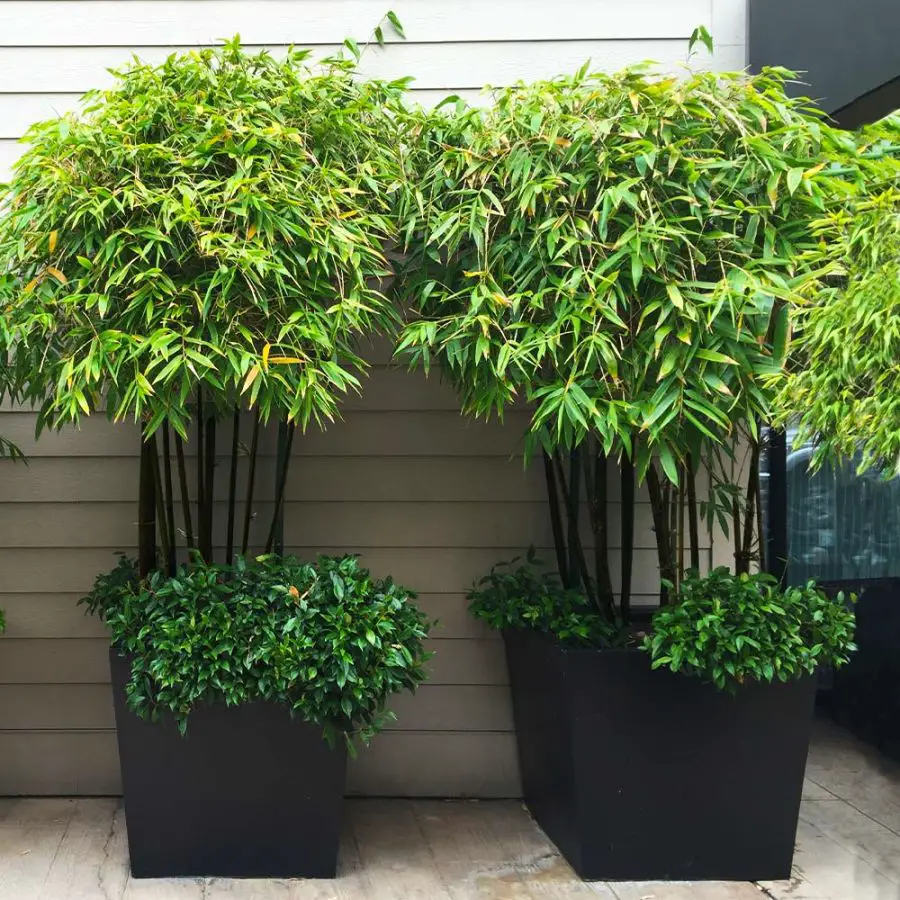
This variety of bamboo is known for its stunning appearance, featuring dark black culms that can add a dramatic touch to any indoor space.
Black bamboo requires moderate to high light conditions and is relatively easy to care for.
It’s a great choice for those looking to add a unique and visually striking element to their indoor garden. Here’s an article about growing black bamboo in pots.
Fernleaf Bamboo:
As the name suggests, the Fernleaf bamboo variety has fern-like leaves that give it a delicate and graceful appearance.
It’s a slow-growing plant that prefers low to moderate light conditions and can be an excellent option for smaller indoor spaces.
With its delicate appearance and low-maintenance nature, Fernleaf bamboo is a great choice for those looking to add a touch of elegance to their indoor garden.
Here is an article about growing fernleaf bamboo indoors.
Selecting the Right Pot
Now that you’ve selected the perfect bamboo variety for your indoor garden, it’s time to choose the right pot for your plant.
Selecting the right pot is crucial to ensuring that your bamboo thrives indoors, as it will impact the plant’s growth, health, and overall appearance.
In this section, we’ll go over some key factors to consider when selecting a pot for your bamboo, as well as some tips on how to choose the right pot size, shape, and material for your indoor plant.
So, grab a cup of tea and get ready to learn all about selecting the right pot for your bamboo plant!
Types of Pots Suitable for Growing Bamboo Indoors
When it comes to selecting the right pot for your indoor bamboo, there are a few different types of pots to consider. Here are some of the most popular options:
Ceramic Pots: These are a popular choice for indoor bamboo, as they come in a range of colors and styles and are relatively easy to find.
Ceramic pots also offer good insulation for your plant’s roots, which can help keep them at a stable temperature.
Plastic Pots: These are a more affordable option than ceramic pots and can be a good idea for those on a budget.
Plastic pots also tend to be lighter than ceramic pots, making them easier to move around as needed.
Terracotta Pots: These pots are made from porous clay material, which allows air and moisture to pass through easily.
This can help promote healthy root growth for your bamboo plant.
Make sure any pot you choose has drainage holes in the bottom of the pot.
Bamboo is usually clumping so if using a large pot you won’t need to repot as often.
Factors to Consider When Selecting Pots for Growing Bamboo
When choosing a pot for your indoor bamboo, there are a few key factors to consider.
First, you’ll want to make sure the pot is the appropriate size for your plant, as a pot that is too small can restrict your plant’s growth and a pot that is too large can lead to over-watering.
A general rule is to select a pot size 2-3 inches larger than the original rootball.
Additionally, you’ll want to consider the pot’s drainage capabilities, as bamboo plants require well-draining soil to thrive.
Don’t try to use a pot without drainage holes.
You’ll also want to consider the pot’s material, as this can impact the pot’s insulation capabilities and how quickly the soil dries out.
Lastly, you may want to consider the pot’s appearance and select a pot that complements your indoor decor.
Preparing the Soil
Now that you’ve selected the perfect pot for your bamboo plant, it’s time to prepare the soil.
Preparing the right soil mixture is crucial to ensuring that your bamboo thrives indoors, as it will provide your plant with the necessary nutrients, drainage, and aeration to promote healthy growth.
In this section, we’ll go over some tips on how to prepare the perfect soil mixture for your indoor bamboo plant.
So, grab your gardening gloves, and let’s get started on creating the perfect soil for your bamboo!
Coco coir and perlite as a soil mix for bamboo
A soil mixture that works well for growing bamboo in pots indoors is a blend of coco coir and perlite.
Coco coir is a sustainable alternative to peat moss and has excellent water retention properties, while perlite improves soil drainage and aeration.
Mix the two together in equal parts and you’ll have well-draining soil that retains moisture without becoming waterlogged.
This soil mix is also lightweight, making it easy to move your pot around if needed. Give it a try and see if it works for your indoor bamboo plant!
Planting Bamboo in Pots
Great, now that we’ve prepared the soil, it’s time to get planting!
Planting bamboo in pots can be a fun and rewarding experience, but it’s important to do it right to ensure your plant thrives.
In this section, we’ll cover the steps you need to follow to successfully plant your bamboo in a pot and give it the best chance of growing strong and healthy.
Let’s get started with step-by-step instructions on how to plant bamboo in pots:
• Fill your pot with the soil mix we prepared earlier, leaving a 2-inch gap at the top for watering.
• Carefully remove your bamboo plant from its current container or wrapping, being sure not to damage the roots.
• Place the bamboo plant in the center of the pot, making sure that it’s straight and upright.
• Fill in the remaining gap around the plant with the soil mix, pressing it down gently as you go.
• Water the plant thoroughly, making sure that the soil is evenly moist but not waterlogged.
• If necessary, stake the plant to provide additional support.
Tips to ensure that your bamboo is planted correctly:
• Make sure the pot you’ve chosen is big enough for the size of the bamboo you’re planting.
• A good rule of thumb is to choose a pot that’s at least twice the size of the plant’s root ball.
• Avoid planting your bamboo too deeply in the soil, as this can lead to root rot. The top of the root ball should be level with the soil surface.
• Don’t compact the soil too tightly around the roots, as this can also impede growth. Gentle pressure is all that’s needed.
• Be sure to water the plant immediately after planting to help settle the soil and hydrate the roots.
Caring for Bamboo in Pots
Congratulations on successfully planting your bamboo in a pot! But your work is not done yet.
To ensure that your bamboo plant continues to thrive and grow strong, it’s important to provide it with the right care.
In this section, we’ll go over the essential steps you need to take to care for your bamboo plant in a pot, from watering and fertilizing to pruning and pest control.
With a little bit of attention and care, your bamboo will become a beautiful and thriving addition to your indoor garden.
Bamboo plants in pots require regular care
Bamboo plants in pots require regular care to keep them healthy and thriving.
This includes watering, fertilizing, pruning, and pest control.
In this section, we’ll cover each of these aspects of care in detail to help you keep your bamboo plant in top condition.
Watering your bamboo in a pot
When it comes to watering your bamboo in a pot, you need to strike a balance between too much water and keeping the soil moist but not overly wet.
We’ll provide tips on how often to water your bamboo plant and how to tell when it needs watering.
Avoid using tap water. It contains chloramine and fluorides which can damage your indoor plants. Use distilled water or rainwater.
We’ll also discuss the best fertilizers to use and when to apply them.
Finally, we’ll cover pruning, an essential task to keep your bamboo plant from becoming too large or unruly.
You’ll learn when and how to prune your bamboo for the best results.
Humidity And Temperature For Bamboo Indoors
Maintaining Ideal Humidity and Temperature for Your Indoor Bamboo
Bamboo plants are a popular choice for indoor decor due to their lush foliage, tall stature, and low-maintenance requirements.
However, to ensure your bamboo thrives indoors, it’s essential to maintain the ideal humidity and temperature levels.
In this blog post, we’ll discuss why humidity and temperature are crucial factors for your bamboo’s health, how to measure them, and the best ways to maintain optimal conditions.
Why Humidity and Temperature Are Important for Indoor Bamboo
Bamboo plants originate from tropical and subtropical regions, where they grow in warm and humid environments.
As a result, they thrive in indoor spaces that replicate these conditions.
If the humidity and temperature levels are too low or too high, your bamboo may experience stress, leaf drop, or even die.
How to Measure Humidity and Temperature
Measuring the humidity and temperature levels in your indoor environment is essential to maintaining ideal conditions for your bamboo.
You can use a hygrometer to measure the humidity level, and a thermometer to measure the temperature.
These tools are readily available at hardware or gardening stores and are relatively inexpensive.
Maintaining Ideal Humidity Levels
Bamboo plants require a humidity level of around 50-60% to thrive.
If your indoor environment is too dry, your bamboo may start to experience leaf drop or brown tips.
Here are some ways to increase humidity levels:
• Use a humidifier: This is one of the most effective ways to increase humidity levels in your indoor environment.
• Group your plants: Placing several plants together can help create a more humid microclimate.
• Mist your plant: Use a spray bottle to mist your plant’s leaves regularly.
• Use a pebble tray: Fill a tray with pebbles and water, and place your plant on top of the pebbles. The water will evaporate, increasing the humidity around the plant.
Maintaining Ideal Temperature Levels
Bamboo plants prefer temperatures between 60-80°F (15-27°C) and can tolerate slightly cooler temperatures at night.
If the temperature is too low, your bamboo may become dormant or experience stunted growth. Here are some ways to maintain ideal temperature levels:
• Place your bamboo near a window: This will provide your plant with natural light and warmth.
• Use a space heater: If your indoor environment is too cold, use a space heater to maintain ideal temperatures.
• Avoid placing your plant near air conditioning vents: Cold air can harm your bamboo, so it’s best to keep it away from vents.
Final Thoughts On Indoor Environment
Maintaining the ideal humidity and temperature levels for your indoor bamboo is essential to ensure its health and longevity.
By following the tips outlined in this blog post, you can create an optimal indoor environment for your bamboo to thrive.
Repotting Bamboo: Everything You Need to Know
Bamboo plants are popular among homeowners due to their low maintenance requirements and stunning appearance.
However, as with all plants, they require proper care and maintenance to thrive.
One essential aspect of bamboo care is repotting.
In this blog post, we will discuss everything you need to know about repotting bamboo, including when to repot, the tools you need, and the steps to follow.
When to Repot Your Bamboo Plant
Ideally, you should repot your bamboo plant every two years. However, some signs may indicate that your plant needs repotting sooner.
For example, if the roots are growing out of the bottom of the pot, or the plant is looking top-heavy, it’s time to repot.
The best time to repot your bamboo is in the spring, just before the growing season begins.
Tools You’ll Need
Before you begin the repotting process, you’ll need a few essential tools. These include:
• A new larger container that’s one size larger than the current pot
• Fresh potting soil
• Pruning shears
• Gardening gloves
• A trowel or garden scoop
Steps to Repot Your Bamboo Plant
Now that you have the necessary tools let’s get started with repotting your bamboo plant:
Carefully remove your bamboo plant from its current pot, being gentle not to damage the roots. You may need to tilt the pot to one side to slide the plant out.
Gently shake off excess soil from the roots.
If the roots are root-bound (tightly packed), use your pruning shears to trim them back.
Add fresh potting soil to the new pot, filling the bottom of the container up to one-third of the way.
Place your bamboo plant in the new pot and adjust its position so that it’s centered.
Add more soil around the plant, filling the pot to an inch below the rim.
Use your fingers to lightly press the soil down around the base of the plant to secure it in place.
Water your newly repotted bamboo plant thoroughly, until excess water starts to run out the bottom.
This will ensure there are no air pockets in the pot. Drain off any excess water from the tray and keep it in a shady spot for a few days before exposing it to direct sunlight.
Final Thoughts On Repotting
Repotting your bamboo plant may seem intimidating, but it’s a simple process that can help ensure your plant remains healthy and happy.
By following the steps outlined in this blog post, you’ll be able to successfully repot your bamboo and enjoy its beauty for years to come.
Propagation of Bamboo
If you’re enjoying growing bamboo in pots indoors, you may be interested in propagating new plants from your existing ones.
Propagation is an exciting way to expand your bamboo collection, and it’s not as difficult as you might think.
In this section, we’ll go over the basics of propagating bamboo plants in pots, including the best time to propagate, the tools you’ll need, and step-by-step instructions for propagating your bamboo successfully.
With a little patience and care, you can grow new bamboo plants to share with friends or add to your indoor garden.
There are several ways to propagate bamboo,
The ways to propagate bamboo include cuttings, division, and layering.
Each method has its own advantages and disadvantages, and the best method depends on the type of bamboo you’re propagating and your personal preferences.
In this section, we’ll discuss the different propagation methods and when they’re most appropriate.
Three methods of propagating bamboo
Cuttings:
Propagation by cuttings involves taking a section of stem or rhizome from an existing bamboo plant and planting it to grow a new one. Bamboo cuttings should be taken during the spring or summer when the plant is actively growing.
Advantages:
Cuttings are a quick and easy way to propagate bamboo, and they can root and grow quickly if they are kept in a warm and humid environment.
This method can be used to create new plants from mature bamboo that may not be able to produce seeds.
Disadvantages:
Cuttings may not always root successfully, especially if the conditions are not optimal.
This method may not be suitable for all types of bamboo, as some varieties do not root well from cuttings.
Division:
Propagation by division involves separating an existing clump of bamboo into smaller sections and planting each section to create a new plant. This method is typically used with running bamboo species.
Advantages:
Division allows you to create multiple plants from a single parent plant, which can be useful if you want to expand your bamboo garden or share your plants with others.
This method ensures that each new plant has a strong root system, as the division is taken from an established clump.
Disadvantages:
Division can be time-consuming and labor-intensive, especially if you are working with a large clump of bamboo.
This method may not be suitable for all types of bamboo, as some species do not form large clumps.
A great time to divide plants is when they need to be repotted.
Layering:
Propagation by layering involves bending a branch of an existing bamboo plant to the ground and burying a section of it in the soil.
Over time, the buried section will develop roots and grow into a new plant.
Advantages:
Layering is a low-maintenance propagation method that does not require special equipment or tools.
This method can be used to propagate plants from an existing parent plant without causing damage to the parent.
Disadvantages:
Layering can be a slow process, as it may take several months for the buried section to develop roots and begin growing.
This method may not be suitable for all types of bamboo, as some species do not bend easily or may not produce enough low-hanging branches to use for layering.
In conclusion, the best method of propagating bamboo depends on the type of bamboo you are working with, your personal preferences, and the resources you have available.
Cuttings, division, and layering are all viable options for propagating bamboo, and each has its own advantages and disadvantages.
Propagating bamboo through cuttings
Propagating bamboo through cuttings is one of the most straightforward methods, and it can be done with a minimal amount of equipment.
We’ll go over the steps involved in taking and rooting bamboo cuttings, including the best time of year to take cuttings, the materials you’ll need, and how to prepare and plant your cuttings.
With a little patience and attention to detail, you can create new bamboo plants that will thrive and bring beauty to your indoor space.
Steps for taking cuttings
Choose a healthy bamboo plant to take cuttings from. Look for a section of stem that is at least 6 inches long and has several nodes (the spots on the stem where leaves and branches grow).
Using a sharp, sterile knife or pruning shears, make a clean cut at a 45-degree angle just below a node.
Remove any leaves or branches from the lower half of the cutting. You want to have at least one node and a few leaves or branches on the top half of the cutting.
Dip the cut end of the cutting in rooting hormone powder, which will help stimulate root growth.
Fill a small pot with a well-draining potting mix, such as a mix of coco coir and perlite.
Make a small hole in the soil and insert the cutting, burying it up to the first node.
Water the soil thoroughly and cover the pot with a clear plastic bag to create a humid environment for the cutting.
Place the pot in a warm, bright location, but out of direct sunlight.
Check the cutting regularly and water as needed. You want moist soil but not waterlogged soil.
After a few weeks, you should see roots beginning to form on the cutting. Once the cutting has developed a strong root system, you can transplant it into a larger pot or into the ground, if desired.
Pruning Bamboo
Pruning is an essential aspect of bamboo care that can help you maintain its shape and health.
In this section, we’ll cover the basics of pruning bamboo in pots indoors.
You’ll learn when and how to prune your bamboo plant to encourage growth and prevent overcrowding. So let’s dive in!
Pruning bamboo
Pruning is important to maintain its shape, encourage growth, and prevent overcrowding.
It’s best to prune bamboo in the spring or summer when it’s actively growing.
Pruning in the fall or winter can result in reduced growth and weakened bamboo.
Steps To Prune Your Bamboo Plant
Start by identifying the culms (stems) that need pruning. Choose the oldest, weakest, or damaged culms for removal.
Cut the culm as close to the soil surface as possible, using sharp, sterilized pruning shears or a saw.
Avoid cutting healthy or new culms, as they contribute to the plant’s growth and vitality.
To encourage growth, you can also selectively remove branches or leaves from the culms.
This can improve air circulation, increase light penetration, and promote new shoots.
Be sure to leave enough leaves on the culm to support photosynthesis and growth.
Remember to dispose of the pruned bamboo properly, as it can be sharp and potentially harmful.
You can use the pruned culms as stakes, trellises, or garden accents, or compost them if you prefer.
How to control height
To control the height of bamboo in pots, you can use a combination of pruning and choosing the right variety of bamboo.
To reduce the height, you can prune the top of the plant or remove entire culms (stems).
However, it’s important to note that over-pruning can weaken the plant and make it more susceptible to disease.
Choosing a variety of bamboo that naturally grows to a shorter height can also help control its growth.
Additionally, limiting the amount of space in the pot can restrict the size of the root system and ultimately limit the plant’s growth.
Troubleshooting Common Problems
Are you experiencing problems with your indoor bamboo? Don’t worry, it’s common to encounter a few issues when growing plants indoors.
In this section, we’ll discuss some of the most common problems that arise when growing bamboo in pots, and how to troubleshoot them.
By following these tips, you’ll be able to keep your bamboo healthy and thriving.
Common problems when growing bamboo in pots indoors
• Overwatering
• Underwatering
• Inadequate sunlight
• Pest infestations
• Soil deficiencies
Step-by-step instructions on how to troubleshoot these problems
Overwatering: reduce the amount of water and increase drainage, avoid keeping water in the tray.
Underwatering: increase watering frequency and check soil moisture regularly.
Inadequate sunlight: move the pot to a sunnier location or supplement with artificial light.
Pest infestations: identify the pest and treat with appropriate measures such as neem oil or insecticidal soap.
Soil deficiencies: fertilize the bamboo with a balanced fertilizer or amend the soil with organic matter.
Insects And Control
Here are some common insects that may affect bamboo plants in pots indoors and some tips for controlling them:
Insects that can affect bamboo plants in pots indoors
Spider mites: These tiny pests can cause yellowing leaves and webbing on the plant.
Mealybugs: Mealybugs are small, white, cotton-like insects that cluster on the undersides of leaves and can cause yellowing and stunting of new growth.
Scale insects: These insects appear as small bumps on the stems and leaves of the plant and can cause wilting and leaf drop.
Tips for controlling insects in bamboo plants in pots indoors
• Use a neem oil solution or insecticidal soap spray to treat spider mites, mealybugs, and scale insects.
• Check regularly for signs of infestation and remove any affected leaves or stems to prevent the spread of pests.
• Keep the bamboo plant in a well-ventilated area and avoid overwatering to discourage the growth of fungal diseases that can attract insects.
Growing Bamboo FAQs
Growing bamboo indoors can be a rewarding experience, and it’s a fantastic way to bring a touch of natural elegance to your living space.
Bamboo plants are relatively low-maintenance and adaptable to indoor conditions, but they still have some specific needs you’ll need to address.
From choosing the right container to understanding the light and watering needs, this FAQ aims to answer the most common questions about growing bamboo in pots indoors.
Q: How do you care for indoor potted bamboo?
A: For indoor bamboo, select a well-draining pot and soil. Place the pot in an area with indirect sunlight and water it regularly, letting the soil dry slightly between waterings. Fertilize lightly every 4-6 weeks.
Q: What is the best container to grow bamboo indoors?
A: A container with drainage holes is essential. Ceramic or plastic pots work well, but choose one that is at least 2 inches larger than the root ball to allow for growth.
Q: Does bamboo grow well indoors?
A: Yes, many species of bamboo adapt well to indoor conditions as long as they get indirect sunlight and proper watering.
Q: Does potted bamboo need sunlight?
A: Bamboo requires indirect sunlight for at least 4-6 hours a day. Too much direct sunlight can scorch the leaves.
Q: How often should you water bamboo indoors?
A: Water your bamboo when the top inch of soil feels dry to the touch. Frequency will vary depending on the climate and indoor conditions, so monitor the soil closely.
Q: How long can bamboo live in pots?
A: With proper care, bamboo can live for several years in pots. Some varieties may outgrow their containers and will need to be repotted or divided.
Growing Bamboo In Pots Indoors Conclusion
In conclusion, growing bamboo in pots indoors is a great way to add a touch of nature to your living space.
By choosing the right bamboo variety, pot, and soil mix, and following the proper care and maintenance techniques, you can enjoy a healthy and thriving bamboo plant right in your own home.
With a little patience, attention, and care, your bamboo plant will not only add beauty to your space but also provide several benefits to your health and well-being.
So why not give it a try and bring some greenery into your home with a beautiful bamboo plant in a pot? Happy gardening!
Final tips for successfully growing bamboo in pots indoors.
A. To recap, growing bamboo in pots indoors can be a rewarding and beautiful addition to your home.
Bamboo has numerous benefits, including air purification, stress reduction, and aesthetic appeal.
By following the steps outlined in this guide, you can successfully grow and maintain your bamboo plants indoors.
Here are some final tips to help ensure the success of your bamboo plants in pots:
Keep your bamboo in a well-lit area with indirect sunlight.
Water your bamboo regularly and make sure the soil is moist, but not waterlogged.
Use a high-quality potting mix and a pot with good drainage.
Fertilize your bamboo periodically to provide it with essential nutrients.
Monitor your plants regularly for any signs of pests or disease, and take action promptly to address any issues.
By following these tips, you can enjoy beautiful and healthy bamboo plants in pots for years to come. Read more about Bamboo Plant Indoor Care









